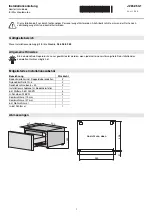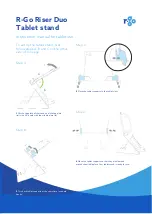
Page 14 of 69
¾
Use a tow vehicle that is large enough for your trailer and has the needed power and heavy-
duty running gear. The tow vehicle must be rated by its manufacturer both to tow the gross
weight, and to carry the hitch weight, of the fully loaded trailer.
¾
Use a weight distributing hitch rated not less than the trailer gross vehicle weight rating
(GVWR). Follow the tow vehicle and hitch manufacturer’s instructions. Install the hitch
ball as close as practical to the rear bumper to minimize rear over-hang.
¾
Use a sway control system, installed and adjusted according to the sway control
manufacturer’s instructions.
¾
Use a break controller that automatically applies the brakes in proportion to the tow vehicle
brakes.
¾
Adjust the brake controller so that the brakes of the trailer operate as quickly as possible
without locking-up the tires of the loaded trailer during strong braking.
¾
Do not use your vehicle’s cruise control while towing.
(Sounds like legalese. Try crossing
Texas or Montana without cruise control.)
¾
Inflate the rear tires of the tow vehicle to the maximum cold pressure.
¾
Inflate the trailer tires to their maximum cold pressure.
¾
Load the trailer placing heavy objects and goods as close to the trailer axle as possible. Do
not place heavy objects on the rear bumper or on the tongue. Try to maintain 10-15% of the
trailer’s weight on the hitch.
¾
Adjust the hitch ball height so that the fully loaded trailer is level front to rear when attached
to the fully loaded tow vehicle with the hitch spring bars tightened.
¾
When loading the trailer, do not exceed the trailer gross axle weight rating (GAWR). Weigh
the fully loaded trailer from time to time to verify that trailer GAWR and GVWR are not
exceeded, and that the loads on the right hand and left hand wheels are approximately equal.
¾
Do not exceed the tow vehicle gross axle weight rating (GAWR) or gross vehicle weight
rating (GVWR). Weigh the tow vehicle from time to time to verify these loadings.
TRAVEL TRAILER LOADING
NOTE: THE USE OF AN EQUALIZER HITCH IS RECOMMENDED. DISCUSS THE
OPTIONS WITH YOUR DEALER AND REFER TO THE MANUFACTURER’S
MANUAL FOR INSTRUCTIONS.
A trailer chassis (springs, wheels, tires, axles, frame and tongue) is designed to carry a certain
maximum weight. This load consists of the weight of the empty travel trailer itself, and weight
added in the form of food, clothing, and anything else that may be stored in, or attached to, the
trailer. The maximum load for which a trailer is designed is called the
Gross Vehicle Weight
Rating (GVWR)
and it is the total of the weight on the axle and the trailer tongue.
Another critical weight factor is the
Gross Axle Weight Rating (GAWR)
. This is the maximum
weight a specific axle is designed to carry. This rating represents the empty vehicle’s axle
weight plus the added load. On trailers with more than one axle, the weight is divided between
each axle and each has its own GAWR. The total of all axle loads plus the tongue weight must
not exceed the trailer GVWR.
Tongue weight is the amount of pressure exerted downward on the hitch ball. Your trailer is
designed for maximum tongue weight that must
NOT EXCEED
your hitch tongue weight
ratings.
Содержание T2801
Страница 2: ...BIGFOOT TRAILER MANUAL DRAFT 8 APRIL 3 2008 ...
Страница 36: ...Page 34 of 69 ...
















































